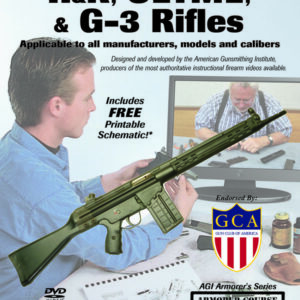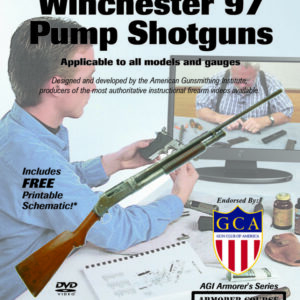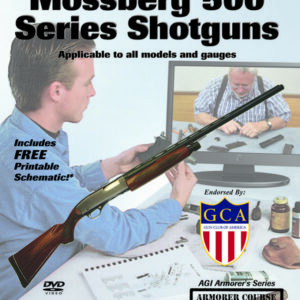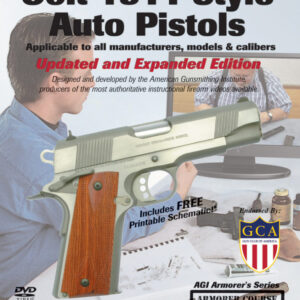Description
The Luger semi-auto pistol was one of the first practical semi-auto pistols and its silhouette is one of the most recognizable in the world. The guns served the Germans through two World Wars and hundreds of thousands of the guns have been brought back by returning GIs and imported.
Bob Dunlap is a renowned expert on most of today and yesterdays important and obscure firearms. He has been a warranty station for most manufacturers, both large and small. His understanding of the design, function, and repair of firearms in general is unsurpassed, and his appreciation of European and exotic arms is legendary among his students. This course is designed to help all of you Luger owners who love the gun, but are a little mystified about its workings. In typical AGI fashion, we use a cut-a way gun, although we almost cried when we cut up a beautiful 1938 Luger, that allows you to actually see how the various parts work and interact.
If you want the quick course on how to get this German classic semi-auto pistol apart, back together, and operating as intended, then this course is for you (if you want the long course, look into our basic 108 hour Professional Gunsmith Course.)
Among the items covered are:
History
- Several reference books discussed
- Designed by Georg Luger, and was descended from the Borchardt pistol which also used a toggle lock which he got from Hiram Maxim
- The gun is beautifully designed and made, tightly machined and very reliable as long as it is kept clean. It is not tolerant of dust and mud, a real failure for a military pistol
- The gun was patented in 1898 and went into production in 1900.
- The Germans through 1943 produced it, although it was officially replaced as the militarys primary service pistol by the Walther P-38 in.1938.
Design Variations
- All Lugers have a sear blocking thumb safety. The majority have a thumb safety that it in the safe position when the lever is down. A few have a safety that is safe in the up position.
- Many Lugers also have grip safeties that also block the sear when in the rearward position
- Some of the guns also have a magazine disconnect safety that has a tab that blocks the rearward movement of the trigger when the magazine is out of the gun
- Because the Germans knew that the Luger is one of the few semi auto pistols that will fire (without blowing up) with the top end off of the gun, a very few destined for the police and civilian market had a safety that prevented the sear from disengaging with the side plate off
- Other variations shown, along with 32 round Snail Drum magazine
Design & Function
- Demonstration and explanation of the operation of the toggle lock action
- The bolt retaining pin, its limitations
- Sear system operation and firing pin retraction shown, explained, and demonstrated.
- The Rube Goldberg around the corner and over the hill trigger linkage shown and demonstrated as well
- Trigger job discussed, but tendency to multiple with limp hold discussed, as well as cure. Pay attention!
- Disconnector system operation shown
- Thumb safety operation shown, simple, safe, effective
- Slide and bolt operation shown, as well as the feed ramp setup
- Take down lever function and operation demonstrated
- How the bolt hold open catch is operated by the magazine loading button
- The reason the S shaped mainspring in earlier guns was replaced with a coil spring and linkage
- Extractor and ejector operation demonstrated
- Loaded chamber indicator. Geladen
Disassembly
- Extensive disassembly, and instructions on how to take apart those parts/assemblies not disassembled, and the reason that they should not be disassembled is explained
- Three different types of magazine end cap retention shown, and one magazine disassembled
- Grip and upper receiver removal
- Upper receiver disassembled
- Side plate disassembly
- Lower receiver disassembled
- Bolt and toggle disassembled
- You get a good look at how the various parts fit together and interact (particularly the springs) after they are removed from the gun and Bob explains things
Cleaning & Lubrication
- AGI cleaning & lubrication methods shown, along with the reasons for their use
- After cleaning, dry with air gun, or in the oven on Warm ~185-200 degrees (metal parts ONLY)
- Lubing the Bob way, and what kind he likes
Reassembly
- Magazine reassembled
- Side plate reassembled
- Bolt and toggle, including firing pin and extractor, reassembly demonstrated
- Firing pin protrusion spec given
- Lower frame assembled
- Upper receiver reassembled
- Upper receiver reassembled on to lower, make sure strut and link get together
- Grips and final reassembly
Accessories
- Be aware of the rules if you attach a shoulder stock
- Original guns are prized, so aftermarket accessories are rare
Troubleshooting
- Trigger problems discussed again
- Failures to feed, cycling problems, their causes, and cures discussed. Do not use wimpy loads in a Luger, particularly longer barreled guns
- What parts tend to break
- Summary
If you noticed how often the terms “explanation” and “demonstration” are used, you may be getting some idea of why this course is necessary for any Luger owner, or someone who intends to be.




